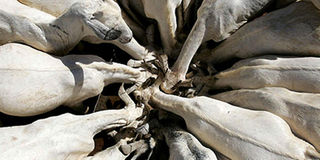Kenya changes tack to wipe out animal-to-human diseases

Goats drink water at a point in northern Kenya. Rift Valley Fever outbreaks are recurrent in the country. PHOTO | FILE | NATION MEDIA GROUP
What you need to know:
- Kenya is one of the 11 African countries set to benefit from the Capacitating One Health in Eastern and Southern Africa (Cohesa) project financed by the European Union, which will enable the experts to work together.
- Uganda, Tanzania, Ethiopia, Mozambique, Botswana, Zimbabwe, Zambia, Rwanda, Malawi and Namibia will also use the ‘One Health’ approach to eradicate the diseases.
Kenya is banking on collaboration of specialists from different sectors in a new strategy to eradicate zoonotic diseases.
The strategy dubbed ‘One Health’ approach involves a multisectoral collaboration of the human, animal and environmental health sectors, among other stakeholders.
In the past, these experts (human health, environment and animal health) have been working independently to address the emergence and spread of zoonotic diseases, which are transmitted through interactions between animals, humans and their shared environments.
Kenya is one of the 11 African countries set to benefit from the Capacitating One Health in Eastern and Southern Africa (Cohesa) project financed by the European Union, which will enable the experts to work together.
Uganda, Tanzania, Ethiopia, Mozambique, Botswana, Zimbabwe, Zambia, Rwanda, Malawi and Namibia will also use the ‘One Health’ approach to eradicate the diseases.
Dr Mathew Muturi, co-leader at Zoonotic Diseases Unit at the Ministry of Health, observed that the strategy seeks to unite human, animal and environment health for better prevention and control of zoonoses.
He spoke recently during a Science cafe organised by ISAAA Africentre that brought together science journalists across the country and experts from around the globe.
He revealed that they are working with devolved units to set up One Health units to build capacity and coordinate efforts to address emerging zoonoses.
“This will enable us to better coordinate surveillance and control of these diseases. We are looking at having better coordination efforts at both the county and national levels,” he explained.
He disclosed that in 2018, the government listed some of the priority zoonotic diseases in the country such as Rift Valley Fever, rabies, anthrax and brucellosis due to prevalence and economic burden.
The ministry estimates that rabies causes 2,000 deaths annually. It is spread through an animal bite. Animals most likely to spread rabies include dogs, bats, coyotes, foxes, skunks and raccoons. “We envision to eliminate deaths caused by rabies by 2030,” said Dr Muturi.
A new World Health Organization (WHO) analysis shows that Africa is facing a growing risk of outbreaks caused by zoonotic pathogens. There has been a 63 per cent increase in the number of zoonotic outbreaks in the region in the decade, from 2012-2022 compared to 2001-2011.
Prof Salome Bukachi from the Institute of Anthropology at the University of Nairobi attributed the rise of zoonotic diseases to human encroachment into wildlife habitats, tropical climate, climate change and wildlife trade around the globe.
“The Cohesa project seeks to work to with key relevant government, research, academic and NGOs to improve the development and uptake of the One Health solutions,” she added.
In Kenya, last year WHO confirmed cases of the Rift Valley fever (RVF) in humans in Isiolo and Mandera counties and in animals in Isiolo, Mandera, Murang’a and Garissa counties.
As of February 4, 2021, there were a total of 32 human cases – with 14 confirmed positive and 11 deaths.
Rift Valley Fever outbreaks are recurrent in Kenya and there have been several reported cases in the past (1998, 2006-2007, 2014, 2018). Last year’s outbreak was associated with rivers and flooding.



